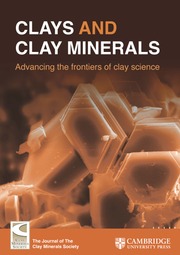Article contents
Clay and Fe (oxyhydr)oxide mineralogy in the basalt weathering profile in Hainan (southern China): implications for pedogenesis process
Published online by Cambridge University Press: 26 July 2024
Abstract
In order to gain a better understanding of clay and Fe (oxyhydr)oxide minerals formed during pedogenesis of basalts in tropical monsoonal Hainan (southern China), a basalt-derived lateritic soil at Nanyang, Hainan, was investigated comprehensively. The results show that the lateritic regolith consists uniformly of kaolinite and Fe (oxyhydr)oxide minerals, with trace gibbsite only in the AE horizon. Abundant dioctahedral smectite in the basalt bedrock formed due to primary hydrothermal alteration, and transformed to kaolinite rapidly in the highly weathering saprolite horizon. The ‘crystallinity’ of kaolinite is notably low and its Hinckley index fluctuates along the soil profile, resulting from intense ferrolysis due to fluctuations between wet/dry climate conditions. From the base to the top of the profile, maghemite shows a decreasing trend, whereas magnetite, hematite, and goethite exhibit a slightly increasing trend, indicating that maghemite formed as an initial product of basalt weathering. Formation of Fe (oxyhydr)oxide species in basalt-derived soil is mainly controlled by local environmental conditions such as soil moisture, redox, and acidic conditions; thus, iron mineral-based paleoclimatic proxies could not be used for subtropical to tropical soils. The highly weathered saprolite has a similar δ56Fe value (+0.06‰) to that (+0.07‰) of the parent rock, while the AE to middle E horizons have greater δ56Fe values of +0.12‰ to +0.19‰. Fe isotopic signatures correlate positively with the Fe mass transfer coefficient (R2=0.77, n=6, ρ<0.05), indicating repetitive weathering and relative accumulation of isotopically heavier Fe in the upper soil horizons, which occurred by reductive dissolution of organic matter under oxic conditions, as reflected by the greater U/Th.
Information
- Type
- Original Paper
- Information
- Copyright
- © The Author(s), 2024. Published by Cambridge University Press on behalf of The Clay Minerals Society
References
- 6
- Cited by


